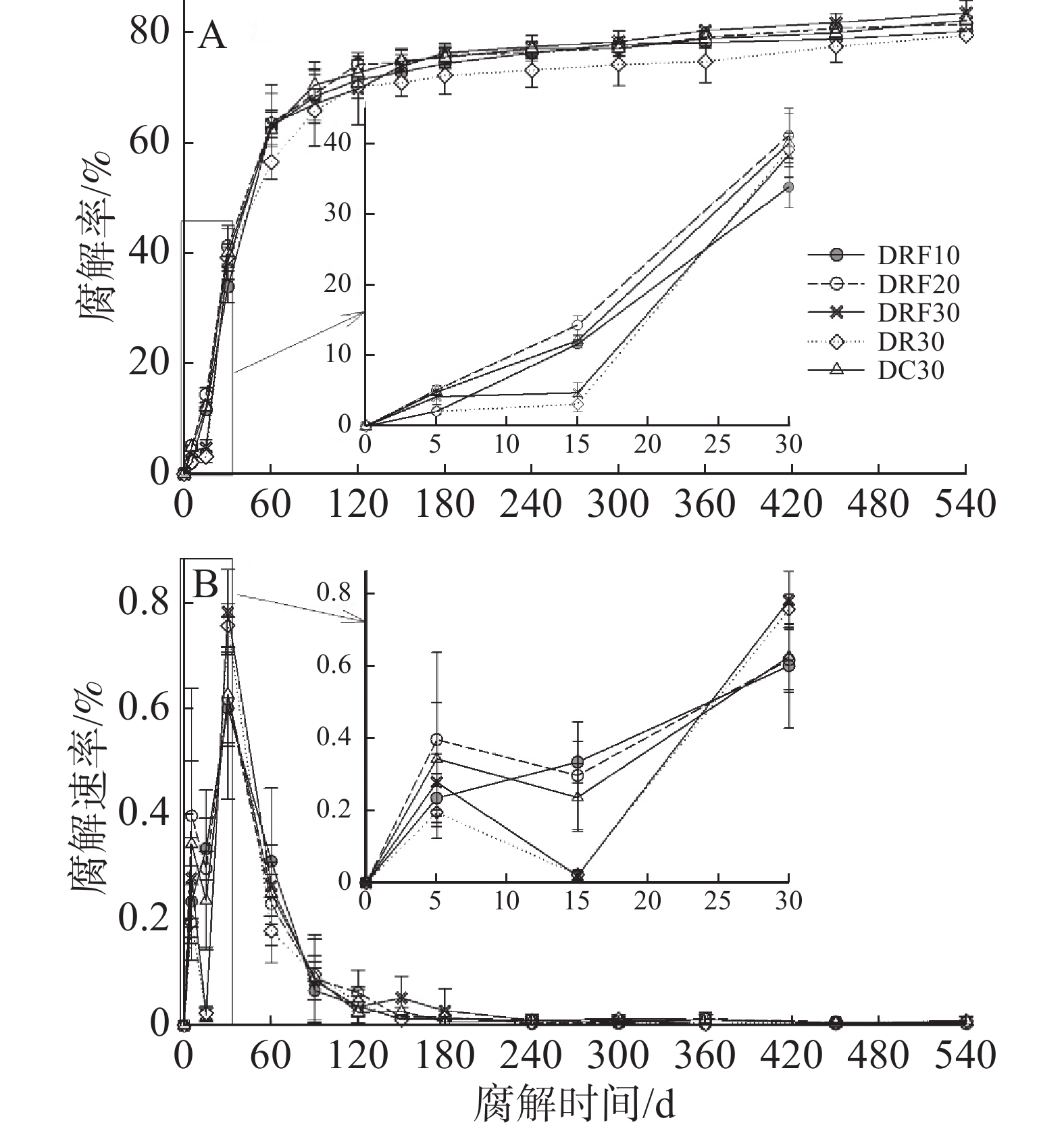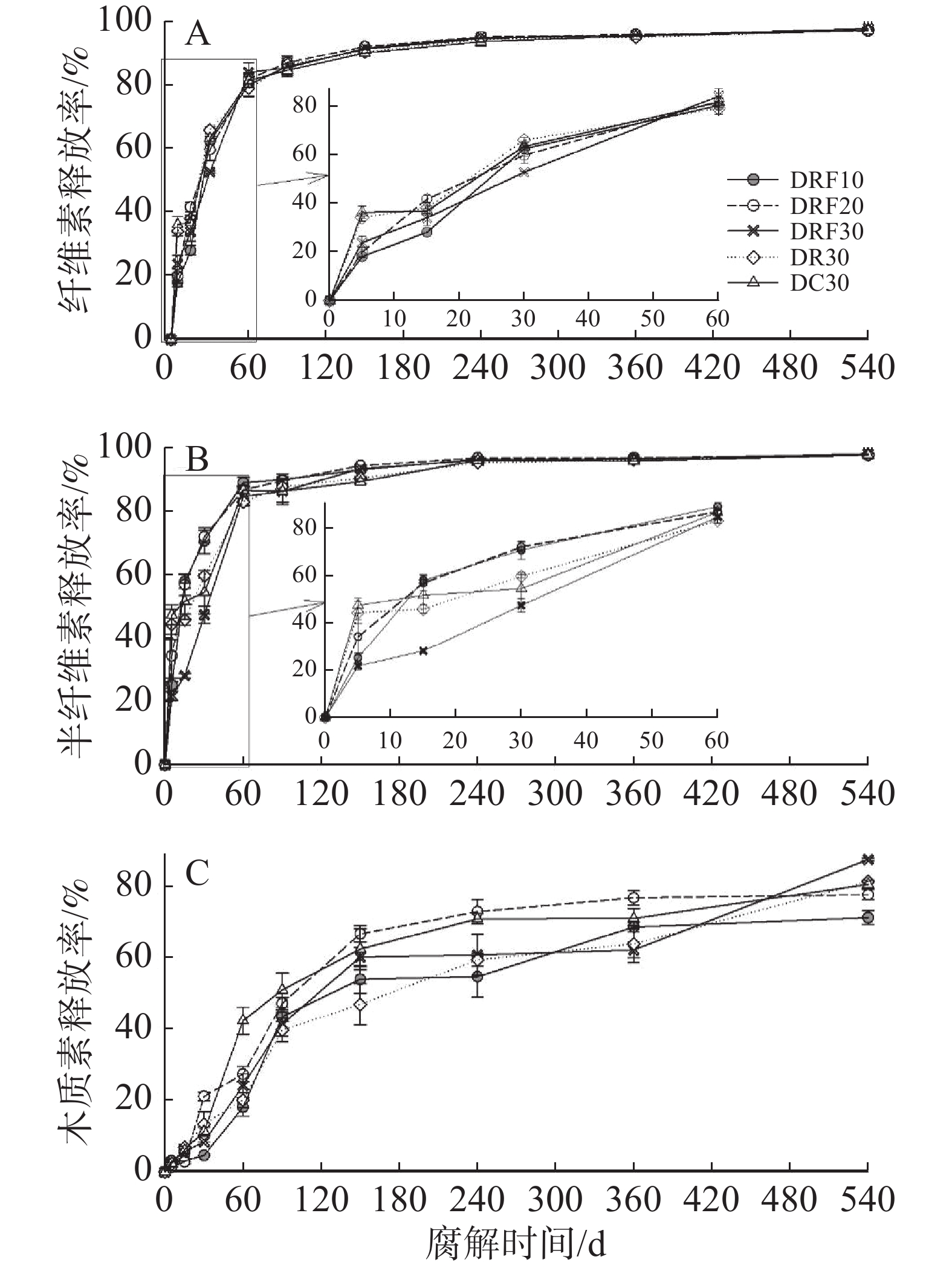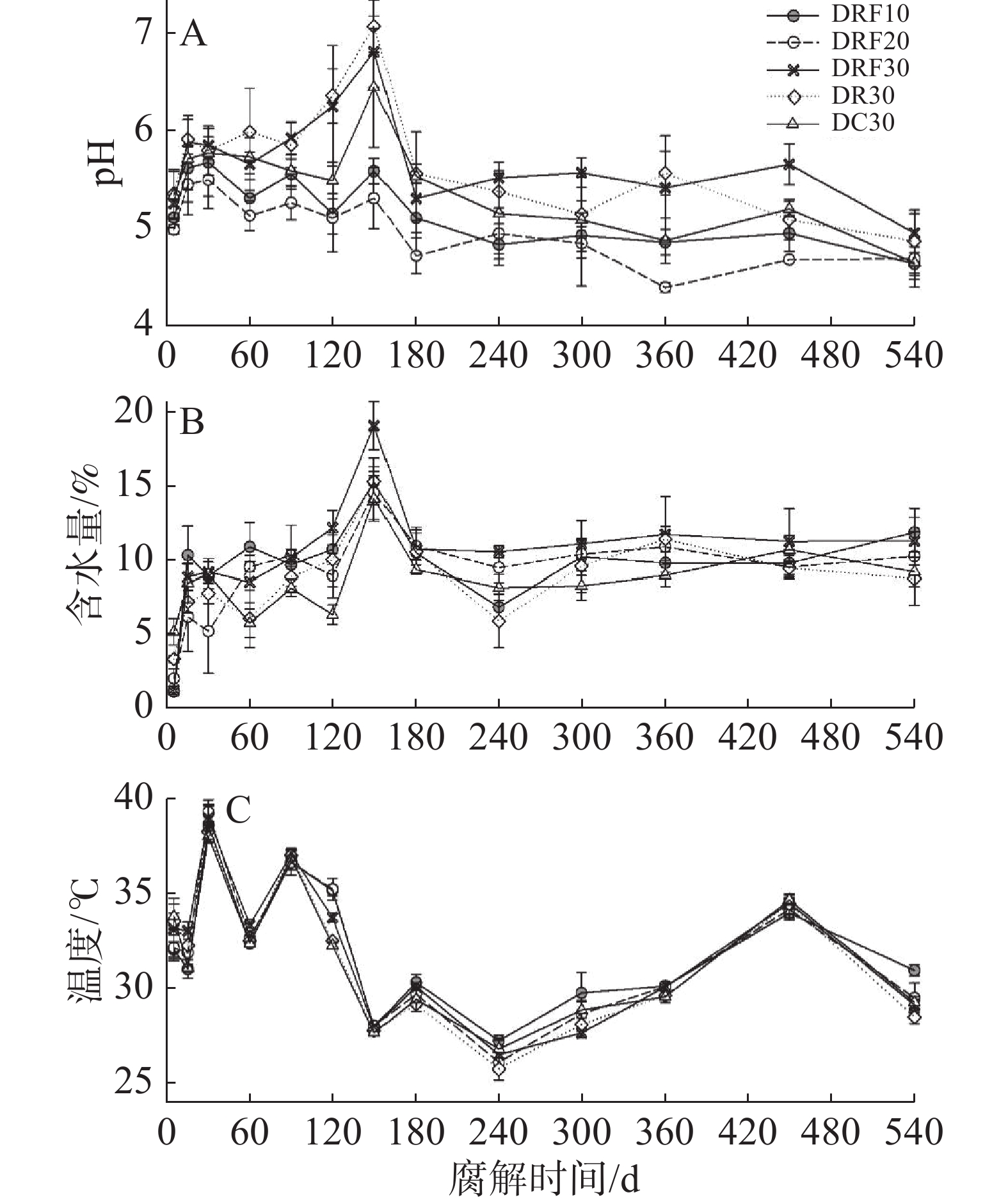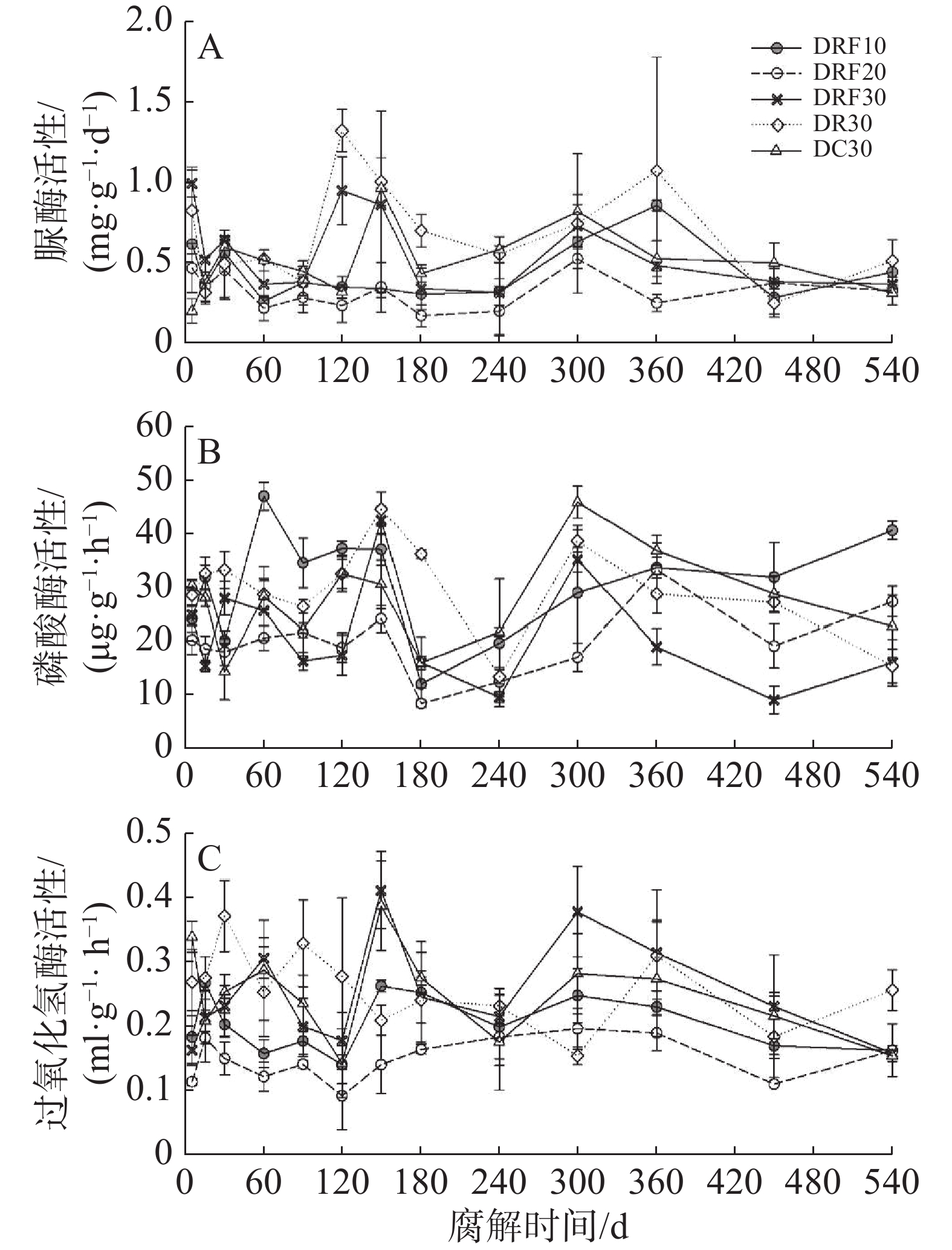-
我国作为农业大国,农业秸秆资源丰富[1-2]。近些年,秸秆还田已作为一项重要的农业可持续利用措施被广泛利用。秸秆还田后在土壤微生物和酶的作用下腐解,释放氮、磷、钾及其他中微量元素供作物吸收利用,提高土壤养分以及有机质含量,提高土壤水分含水量,进而提升作物产量[3-5],并能解决农业资源的浪费和缓解肥料的过量施用所带来的土壤退化及环境污染问题[6-7]。因此,秸秆还田在农业上已备受关注。
秸秆还田后的腐解率、腐解速率及其受土壤环境的影响是秸秆还田效果发挥的关键。秸秆腐解会受到秸秆特性、环境因素以及土壤微生物等因素的影响[8-10]。有研究表明,由于大豆秸秆的碳氮比远低于玉米秸秆,更适合微生物的活动,导致其秸秆腐解速率较快[9,11]。同时,秸秆中纤维素、半纤维素和木质素含量也是影响秸秆腐解速率的因素,陈尚洪等[12]指出秸秆中纤维素和木质素含量越高,秸秆中分解速率越慢。埋深20 cm玉米秸秆腐解率要显著高于埋深35 cm处理,且松原地区玉米秸秆腐解率要快于长春地区[13]。另外,秸秆翻压在重壤土中腐解要快于轻壤土;土壤在低pH条件下微生物活性降低,秸秆腐解速率减慢[14]。有研究还发现,在27 ℃左右和土壤含水量在16%~20%范围内,秸秆腐解速率最快[15-16]。可见,秸秆类型、秸秆埋深及环境条件等的不同都会造成秸秆腐解特性的不同。。
菠萝[Ananas comosus(L.)Merr.]作为一种重要的热带水果,在热带地区大面积种植[17]。菠萝收获后产生的茎、叶等秸秆量巨大,但当今除少量被粉碎还田外,绝大部分被焚烧或丢弃[18]。菠萝秸秆中氮磷钾等养分元素以及有机质含量丰富,可以为作物提供养分[15]。刘传和等 [18]的研究表明,菠萝秸秆还田后可提高土壤养分和酶活性,和降低土壤容重,同时提高了菠萝产量。然而菠萝秸秆还田后其腐解特性还鲜有研究。秸秆沟埋还田可以提高秸秆层的土壤温度、养分以及有机质含量,改变土壤微生物群落组成,进而提高作物产量[19-21]。沟埋还田措施已在小麦、水稻等作物上有很多研究和应用[6,22],但目前菠萝秸秆还田主要集中在翻耕还田上,沟埋还田的应用还未有研究,因此本研究基于不同菠萝秸秆沟埋还田模式,研究其对菠萝秸秆腐解特性的影响,为菠萝秸秆沟埋还田方式在热带地区的应用与研究奠定基础。
-
试验地点为海南省乐东黎族自治县海南大学热带作物学院试验基地(108°46′E,18°39′N),气候为典型的热带季风气候,土壤类型为热带地区燥红土,试验田土壤(0~20 cm)基本理化性质为pH 4.75,有机质含量 7.57 g·kg−1,碱解氮含量 23.33 mg·kg−1,速效磷含量 118.52 mg·kg−1,速效钾含量 99.00 mg·kg−1。菠萝秸秆腐解期间的日平均温度和日累计降水量见图1。
-
秸秆选用台农17号菠萝秸秆,秸秆的基本特性指标为全氮含量4.96 g·kg−1,全磷含量1.65 g·kg−1,全钾含量7.14 g·kg−1,纤维素含量125.40 mg·g−1,半纤维素含量179.18 mg·g−1,木质素含量132.27 mg·g−1。
-
试验采用5种沟埋还田处理,分别为①沟埋10 cm还田起垄覆膜(DRF10);②沟埋20 cm还田起垄覆膜(DRF20);③沟埋30 cm还田起垄覆膜(DRF30);④沟埋30 cm还田起垄(DR30);⑤沟埋30 cm还田平作(DC30)。本试验采用尼龙网袋法进行秸秆腐解试验[10]。将秸秆烘干后剪碎(5 cm)进行试验,装入尼龙网袋(200目,15 cm×20 cm)中,每袋40 g。试验在菠萝苗移栽当天(2021-05-23)将装有菠萝秸秆的网袋按不同处理的要求埋入土中。
-
从菠萝移栽后5(2021-05-28)、15、30、60、90、120、150 、180、240、300 、360 、450、540 d取出埋入土中的秸秆。取出秸秆后于烘箱中60 ℃烘干至恒重后称质量,并计算腐解率和腐解速率[23]。腐解率(%)=(0天的干物质量−n天的干物质量)/0天的干物质量。腐解速率(g·d−1)=(m天的干物质量−n天的干物质量)/(m−n)天。将过筛后的秸秆称质量,使用试剂盒(苏州格锐思生物科技有限公司)测定秸秆中纤维素含量、半纤维素含量、木质素含量。纤维素或半纤维素或木质素释放率(%)=[1−(Mt Ct)/(M0 C0)]×100。Mt为t天秸秆干物质量,Ct为t天秸秆纤维素含量或半纤维素含量或木质素含量,M0为秸秆原始干物质量,C0为原始秸秆纤维素含量/半纤维素含量/木质素含量[24]。
-
取秸秆样的同时,在每个小区随机取秸秆层土壤样品,将其带入实验室用于其他土壤性状指标的测定。与秸秆取样时间一致,土壤温度使用地温计测定不同秸秆层土壤的温度。土壤水分含量采用烘干法测定[25]。土壤pH值采用pH计电位法测定,水土质量比为2.5∶1[25]。脲酶活性用靛酚比色法测定[26],酸性磷酸酶用磷酸苯二钠比色法测定[26],过氧化氢酶活性采用高锰酸钾滴定法测定[26]。
-
采用 Excel 2019 进行数据整理,采用Statistix 8进行数据分析,采用 SigmaPlot 14.0 进行数据作图,处理间差异显著性使用LSD检验法比较。
-
不同沟埋还田处理对秸秆腐解率和腐解速率的影响见图2。菠萝秸秆还田后呈现出先慢后快之后又逐渐变慢的“S”型腐解趋势(图2-A),其腐解主要聚集在还田腐解前60 d,腐解率达到56%以上;还田腐解60~180 d内秸秆腐解率增幅变小,仅增加11%~16%;180~540 d秸秆腐解率增加更为缓慢,仅增加了5%~8%。同时,秸秆腐解速率在还田腐解15~30 d达到最高,之后缓慢下降。在秸秆还田腐解15 d,DRF20处理腐解率最高,其腐解率为14.31%,显著高于其他处理(P<0.05);而DRF30和DR30处理下秸秆腐解率和腐解速率最低,显著低于其他处理。还田腐解30 d后,DRF20处理秸秆腐解率最高,显著高于DRF10处理(P<0.05),但与其他处理间并没有显著差异;并且各处理间的腐解速率并没有显著差异。各处理在还田腐解540 d时秸秆腐解率超过了79%,其中DRF30显著高于其他4个处理。整个腐解过程中DR30处理秸秆腐解率和腐解速率都表现最低,在还田腐解540 d显著低于其他处理(P<0.05)。
-
不同沟埋还田处理对秸秆纤维素、半纤维素、木质素的释放率的影响见图3。秸秆还田后秸秆中纤维素和半纤维素在还田腐解0~60 d之内迅速释放,释放率分别超过了79%和83%;还田腐解60 d后释放逐渐变慢。还田腐解15 d,DRF20处理纤维素释放率显著高于其他处理(P<0.05),但半纤维素释放率与DRF10无显著性差异,纤维素和半纤维素释放率分别以DRF10和DRF30处理最低,与其他处理差异显著。还田腐解30 d,DRF30处理下纤维素和半纤维素的释放率显著低于其他处理(P<0.05);DR30处理纤维素释放率显著高于DRF20和DRF30处理。还田腐解60 d时DRF30处理的纤维素释放率显著高于DR30;DRF10处理的半纤维素释放率最高,DR30处理的最低。还田腐解540 d时各处理间纤维素和半纤维素的释放率没有明显差异。
秸秆木质素释放率表现为还田腐解0~15 d缓慢释放,还田腐解15~150 d释放率增加,超过了46.94%;还田腐解150 d后释放率逐渐减小。还田腐解30 d时DRF20木质素释放率最高,而DRF10处理最低,且与其他处理间差异显著。还田腐解150 d时,DRF20处理秸秆木质素释放率显著高于DR30(P<0.05)。还田腐解540 d时,DRF30处理秸秆木质素释放率显著高于其他处理(P<0.01),但DRF10显著低于其他处理(P<0.01)。
-
不同沟埋还田处理对土壤理化性质的影响见图4。秸秆集中层土壤pH值在整个腐解过程中呈现出随着腐解时间增长,pH值先增加后降低的趋势,在还田腐解150 d时各处理pH值达到最大。还田腐解150 d时各处理pH值在5.31~7.08范围,其中DR30和DRF30显著高于其余处理(P<0.05),但其之间差异不显著(P>0.05);DRF20处理pH最低,显著低于其余处理(P<0.05)。秸秆还田后各处理秸秆集中层土壤含水量表现为单峰型曲线,在秸秆还田腐解150 d达到最高值。DRF10、DRF20、DRF30处理含水量在整个腐解期间高于DC30和DR30,且在还田腐解150 d,DRF30要显著高于其他处理(P<0.05)。各处理土壤温度均受季节温度影响较大,土壤温度表现为夏季温度高而冬季温度低。土壤温度总体表现出DRF30>DRF10>DRF20>DC30>DR30,但各处理间差异并不总显著。
-
不同沟埋还田处理对土壤酶活性的影响见图5。土壤中脲酶、磷酸酶和过氧化氢酶活性在菠萝秸秆腐解过程中均表现为在还田腐解前150 d逐渐增加,到还田腐解150 d时酶活性最大,之后降低;在还田腐解240 d之后逐渐增加,到还田腐解300 d后又逐渐降低。还田腐解150 d时DRF30、DR30和DC30处理的脲酶活性显著高于DRF10和DRF20;磷酸酶活性则表现为DRF30和DR30处理显著高于其他3个处理,DRF20最低;过氧化氢酶活性表现为DRF30和DC30处理显著高于其他处理(P<0.05)。还田腐解300 d时磷酸酶活性以DC30处理最高,且显著高于其他处理(P<0.01),其次为DR30处理,而DRF20处理最低,DR30处理、DRF20处理与其他处理间差异显著;DRF30处理过氧化氢酶活性也表现出显著高于其他处理(P<0.05)。
-
秸秆腐解率与纤维素、木质素的释放率呈显著正相关(P<0.05),而与磷酸酶呈显著负相关(P<0.05)(表1)。尽管秸秆腐解率、半纤维素释放率、土壤含水量与土壤温度呈正相关,而与土壤的脲酶和过氧化氢酶呈负相关,但其并不显著。秸秆纤维素、半纤维素和木质素的释放率之间呈极显著正相关(P<0.01)。脲酶、过氧化氢酶与pH值呈极显著正相关;脲酶与磷酸酶、过氧化氢酶呈显著正相关。
SDR/% CR/% HR/% LR/% SWC/% ST/℃ pH UA/(mg·g−1·d−1) PA /(μg·g−1·h−1) CR/% 0.52* HR/% 0.51 0.93** LR/% 0.61* 0.90** 0.87** SWC/% 0.25 −0.09 −0.23 0.01 ST/℃ 0.39 −0.21 −0.21 −0.11 0.52* pH −0.08 0.44 0.37 0.42 −0.11 −0.61* UA/(mg·g−1·d−1) −0.40 0.25 0.22 0.28 −0.26 −0.44 0.75** PA/(μg·g−1·h−1) −0.54* −0.38 −0.47 −0.31 0.26 0.08 0.24 0.61* CA/(ml·g−1·h−1) −0.04 0.29 0.23 0.43 0.11 −0.34 0.86** 0.75** 0.46 注:*表示指标之间显著相关(P<0.05);**表示指标之间极显著相关(P<0.01);SDR表示秸秆腐解率; CR表示秸秆纤维素释放率;HR表示秸秆半纤维素释放率;LR表示秸秆木质素释放率;SWC表示土壤含水量;ST表示土壤温度;UA表示脲酶活性;PA表示磷酸酶活性;CA表示过氧化氢酶活性。 -
作物秸秆腐解率和腐解速率是表征秸秆腐解情况的重要指标[27]。菠萝秸秆腐解过程中表现出先快后慢的趋势,这与他人的研究结果相似[28-30]。菠萝秸秆腐解主要聚集在还田腐解前60 d,这是由于秸秆还田后秸秆中易分解有机物质以及无机养分释放入土壤中,给微生物提供生长繁殖所需养分,微生物群落组成发生了迅速变化,这导致秸秆中纤维素、半纤维素、脂肪族化合物、酰胺类化合物和糖类等物质在前期能较快地被分解,加速秸秆腐解矿化[24,31-33];另外,秸秆还田后,高降雨量及温度也为微生物创造了较好的环境条件,促进微生物活力增加,促进秸秆腐解[9,34]。因此,菠萝秸秆纤维素和半纤维素在还田腐解前60 d也表现出了快速释放。该结果与西北地区大豆和玉米秸秆腐解率相比[33],菠萝秸秆前期腐解速率快,且持续时间长(延长大约30 d),腐解率达56%的时间提前了大约120 d; 这可能主要跟秸秆特性和不同地区的环境条件有密切关系。纤维素、半纤维素和木质素是影响秸秆腐解的重要因素,且纤维素和半纤维素较木质素更容易分解[24]。在秸秆还田腐解60 d后,秸秆中较难分解的物质(如木质素、单宁和蜡质等)逐渐增加,导致秸秆腐解速率减慢;在还田腐解前60 d,木质素的释放率还未达到40%,而到还田腐解540 d,木质素释放率才超过71%,而纤维素和半纤维素释放率均已超过95%。随着菠萝秸秆的腐解,秸秆中氮、磷、钾等养分快速释放,致使土壤中酸性磷酸酶、脲酶和过氧化氢酶在秸秆腐解速率最快的阶段活性略有降低,并且由于海南农田速效磷含量高,磷酸酶变化更明显。因此,本研究也发现秸秆腐解率与纤维素释放率、木质素释放率呈显著正相关,而与土壤磷酸酶呈显著负相关关系。该结果也证实了秸秆纤维素、木质素的释放率是与菠萝秸秆腐解密切相关的因素,同时菠萝秸秆腐解会对土壤养分产生明显的影响。
影响秸秆腐解的因素有多种,如土壤温度、土壤含水量及秸秆自身因素等[9,35-36]。土壤温度和含水量都表现出与秸秆腐解呈正相关关系[11,16],能促进菠萝秸秆腐解。菠萝秸秆还田腐解15 d,温度和降雨都较少,10 cm土层含水量低于其他土层,而30 cm土层土壤温度也表现出低于其他土层;与其他土层相比,20 cm土层土壤含水量和温度都较为适宜土壤微生物及酶活性的提高,进而使DRF20处理较其他处理能够显著提高秸秆纤维素、半纤维素的释放率,其腐解率也显著高于其他处理(P<0.05)。DRF30、DR30处理由于土层较深,土壤温度低且通气状况较差,不利于土壤微生物对秸秆的分解[10,22,28],降低了秸秆纤维素、半纤维素和木质素等的分解,这导致其腐解率和腐解速率最低,显著低于其他处理(P<0.05)。菠萝秸秆还田腐解30 d,温度和降雨增加,但由于地膜覆盖DRF10土层通透性差且温度高,导致DRF10处理腐解率最低。秸秆还田腐解60 d,由于温度和降雨减少,DRF10处理土壤温度和水分含量适宜,秸秆易分解的物质快速减少,其腐解率与其他处理间的差异逐渐变小,无显著性差异。可见,土壤温度、含水量及通气状况都是影响菠萝秸秆腐解的重要因素,以上因素协同作用时秸秆才会腐解速度加快。秸秆还田腐解60 d之后,DRF30处理腐解率逐渐高于其余处理,这是因为DRF30处理土壤pH值较高,而pH值的提高有利于木质素结构的破坏和微生物的繁衍,进而促进秸秆腐解[37]。到还田腐解540 d时DRF30处理木质素释放率和秸秆腐解率都显著高于其他处理(P<0.05)。本研究中菠萝秸秆木质素释放率与土壤pH间也呈现出正相关关系。在菠萝秸秆腐解前期,DRF20处理前期秸秆腐解和养分释放过快,导致中后期土壤养分降低,土壤脲酶和过氧化氢酶活性显著降低,磷酸酶活性增加。DR30处理由于起垄后透气性较差,且温度低于覆膜处理,并且在厌氧条件下木质素的一种结构酚羟基易与土壤中无机氮结合,降低了木质素的分解[29],这使得秸秆腐解率及养分释放低于其他处理,秸秆腐解中后期土壤养分略高于其他处理,土壤脲酶和过氧化氢酶活性增加,磷酸酶活性降低。可见,DRF20处理更有利于菠萝秸秆的腐解。
综上所述,菠萝秸秆还田后其腐解主要聚集在还田腐解前60 d,腐解率、纤维素释放率、半纤维素释放率及木质素释放率分别能达到56%、79%、83%和18%以上;且在还田腐解15~30 d腐解率最快;还田腐解540 d腐解率会超过79%。菠萝秸秆腐解率与秸秆中纤维素和木质素释放率呈显著正相关关系,而与土壤磷酸酶呈显著负相关关系。DRF20处理由于土壤温度和水分适宜,秸秆纤维素、半纤维素和木质素分解率高,在还田前期腐解率最高;而DRF30处理还田中后期腐解更快。但不同处理下菠萝秸秆的腐解特性对热区农田土壤肥力及作物产量有何影响也将成为未来菠萝秸秆还田研究的重点。
Decomposition characteristics of pineapple plant residues returned to the soil in different ditches
doi: 10.15886/j.cnki.rdswxb.20230054
- Received Date: 2023-04-22
- Accepted Date: 2023-10-13
- Rev Recd Date: 2023-06-19
- Available Online: 2023-12-05
- Publish Date: 2024-03-20
-
Key words:
- pineapple plant residues /
- returning of plant residues to the field /
- decomposition characteristics /
- soil characteristics
Abstract: Returning straw to soil in ditches can increase soil temperature, nutrients and organic matter content, change soil microbial community composition, and thus increase crop yield. However, this method has not been reported to use in returning pineapple plant residues to soil in the field. Five treatments for ditching and returning the pineapple plant residues to the soil in the field were designed: Ditching 10 cm deep, returning the plant residues into soil in the ditches, ridging and covering with film (DRF10); ditching 20 cm deep, returning the plant residues to the soil in the ditches, ridging and covering with film (DRF20); ditching 30 cm deep, returning the plant residues to the soil in the ditches, ridging and covering with film (DRF30); ditching 30 cm deep, returning the plant residues into the soil in the ditches and ridging (DR30); ditching 30 cm deep, returning the plant residues into the soil in the ditches and leveling (DL30). The decomposition characteristics of the pineapple plant residues buried in different ditches were observed and analyzed. The results showed that the decomposition of the pineapple plant residues mainly occurred in the first 60 days after they were returned to the soil, with a decomposition rate of more than 56%. The decomposition rate of the plant residues was the highest at 15-30 days after returning to the soil. In the DRF20 treatment, the cellulose release rate and decomposition rate were significantly higher at 15 days after returning to the field, and the lignin release rate and decomposition rate were also the highest after 30 days of returning to the soil. The decomposition and decomposition rate, release rate of cellulose and hemicellulose were significantly lower in the DRF30 treatment than in the other treatments. The lignin release rate and decomposition rate were significantly higher in the DRF30 treatment than the other treatments at 540 days after returning to the soil. Soil water content and temperature were higher in the DRF30 treatment than in the DR30 and DL30 treatments. The enzyme activities were higher in the DRF30, DR30 and DC30 treatments than in the other treatments, but not significantly. The decomposition rate of the pineapple plant residues was positively correlated with the release rate of cellulose and lignin and negatively correlated with phosphatase. In conclusion, the pineapple plant residues decomposed fast at the early stage in the DRF20 treatment but at the middle and late stages in the DRF30 treatment.
| Citation: | YANG Shuyun, CAI Jinwen, LI Shoupeng, HAN Yan, JIN Xin, HOU Guangqing, SHAO Xujie, CHENG Wenxiao, LI Changjiang. Decomposition characteristics of pineapple plant residues returned to the soil in different ditches[J]. Journal of Tropical Biology, 2024, 15(2): 133-140. doi: 10.15886/j.cnki.rdswxb.20230054 |


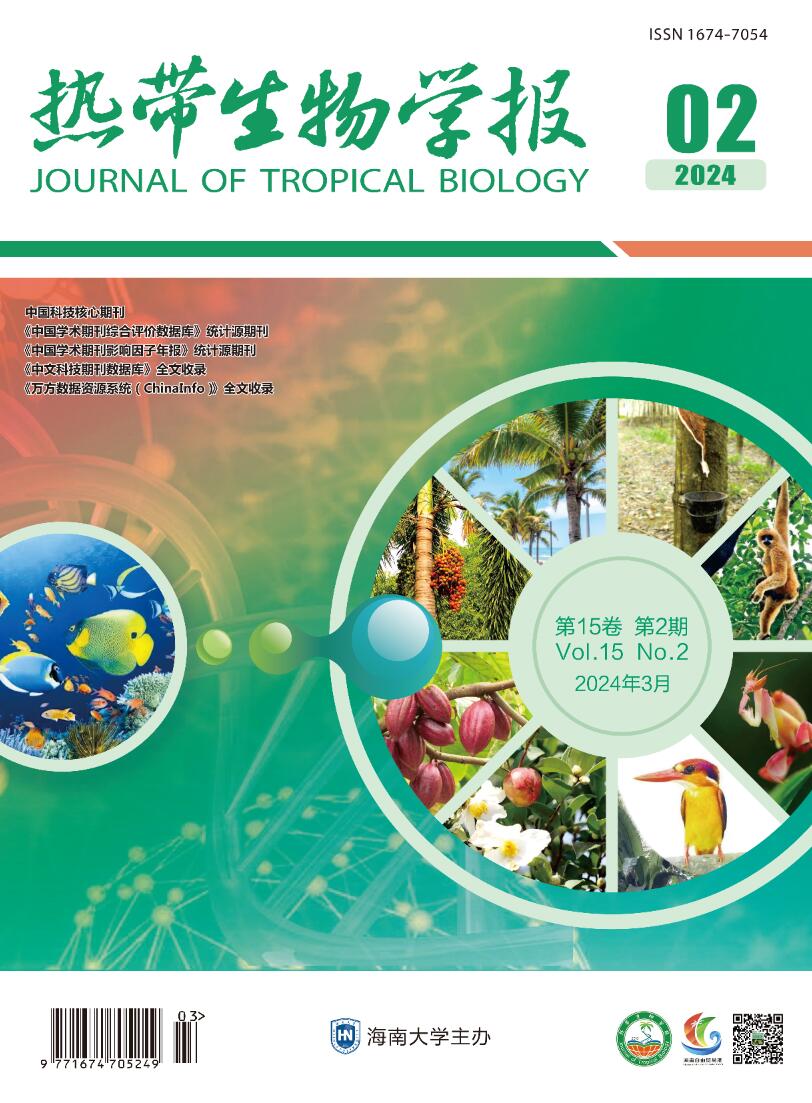


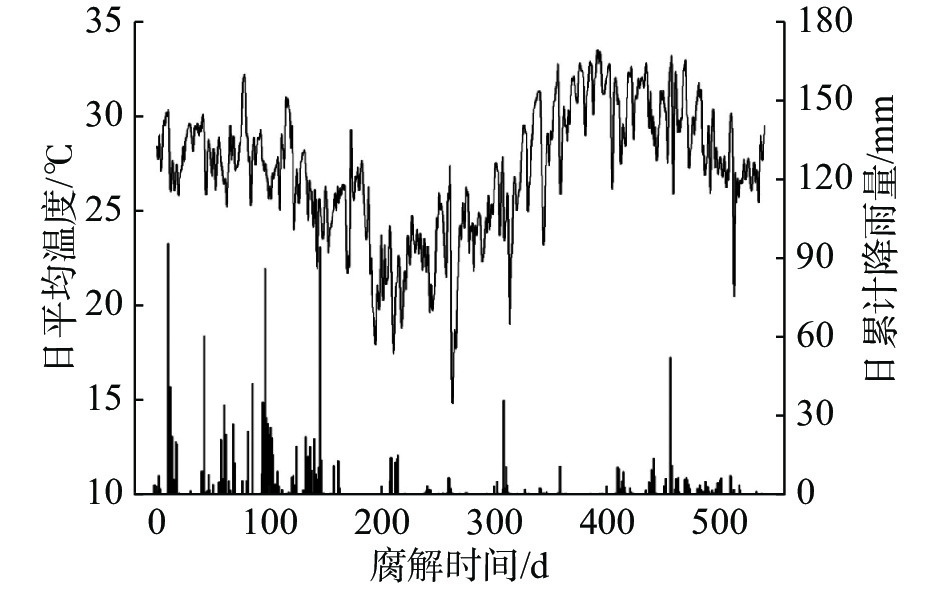

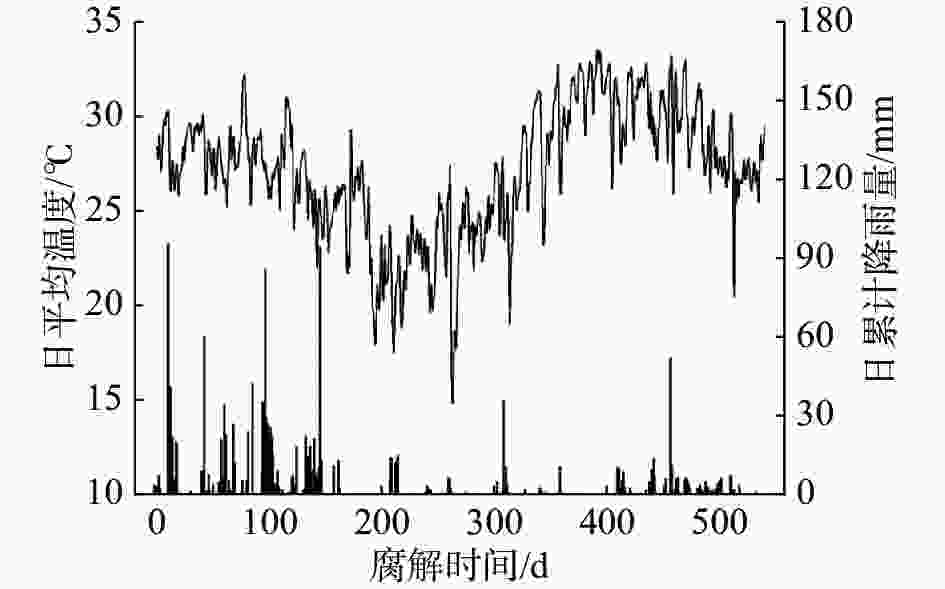
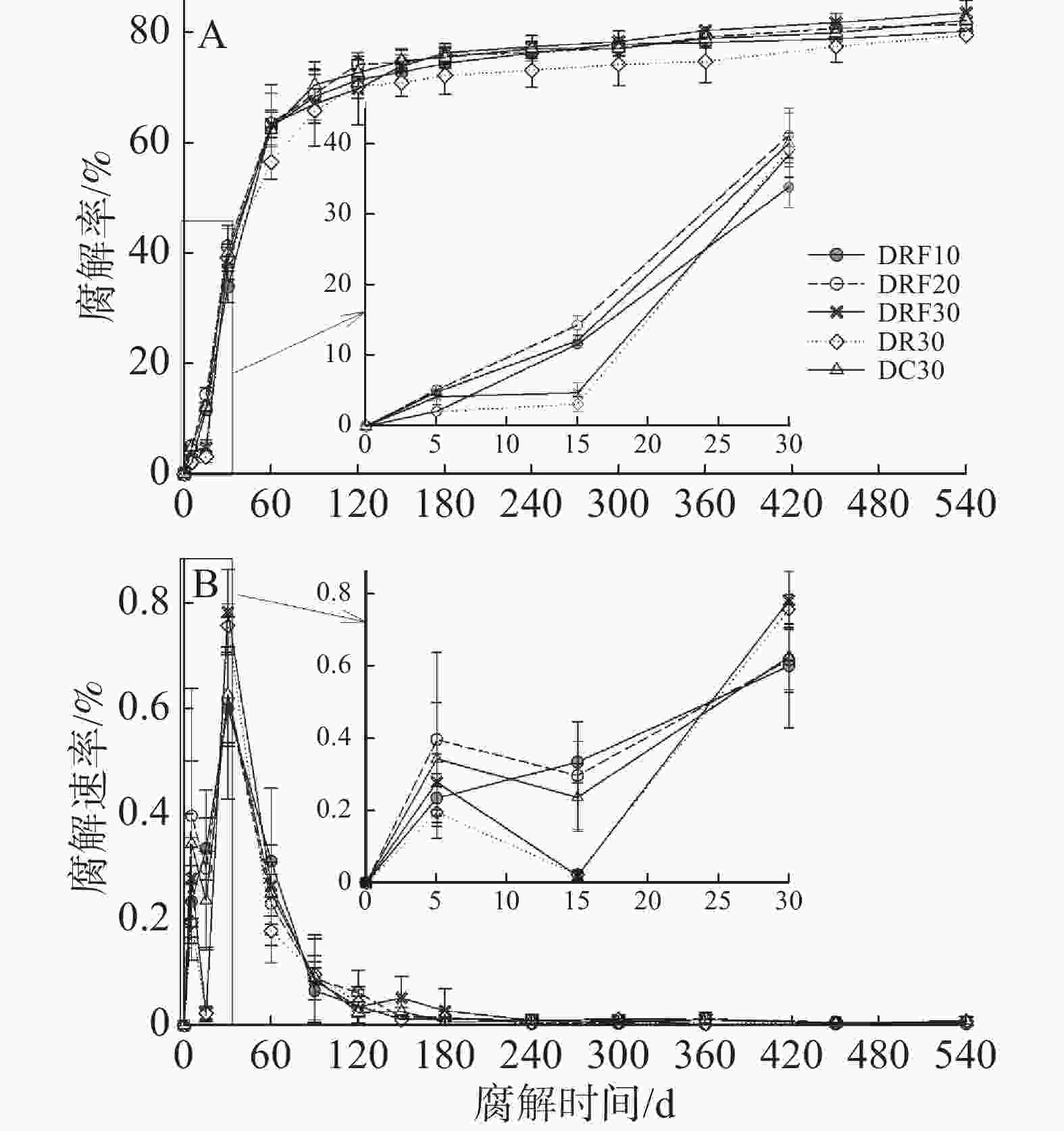
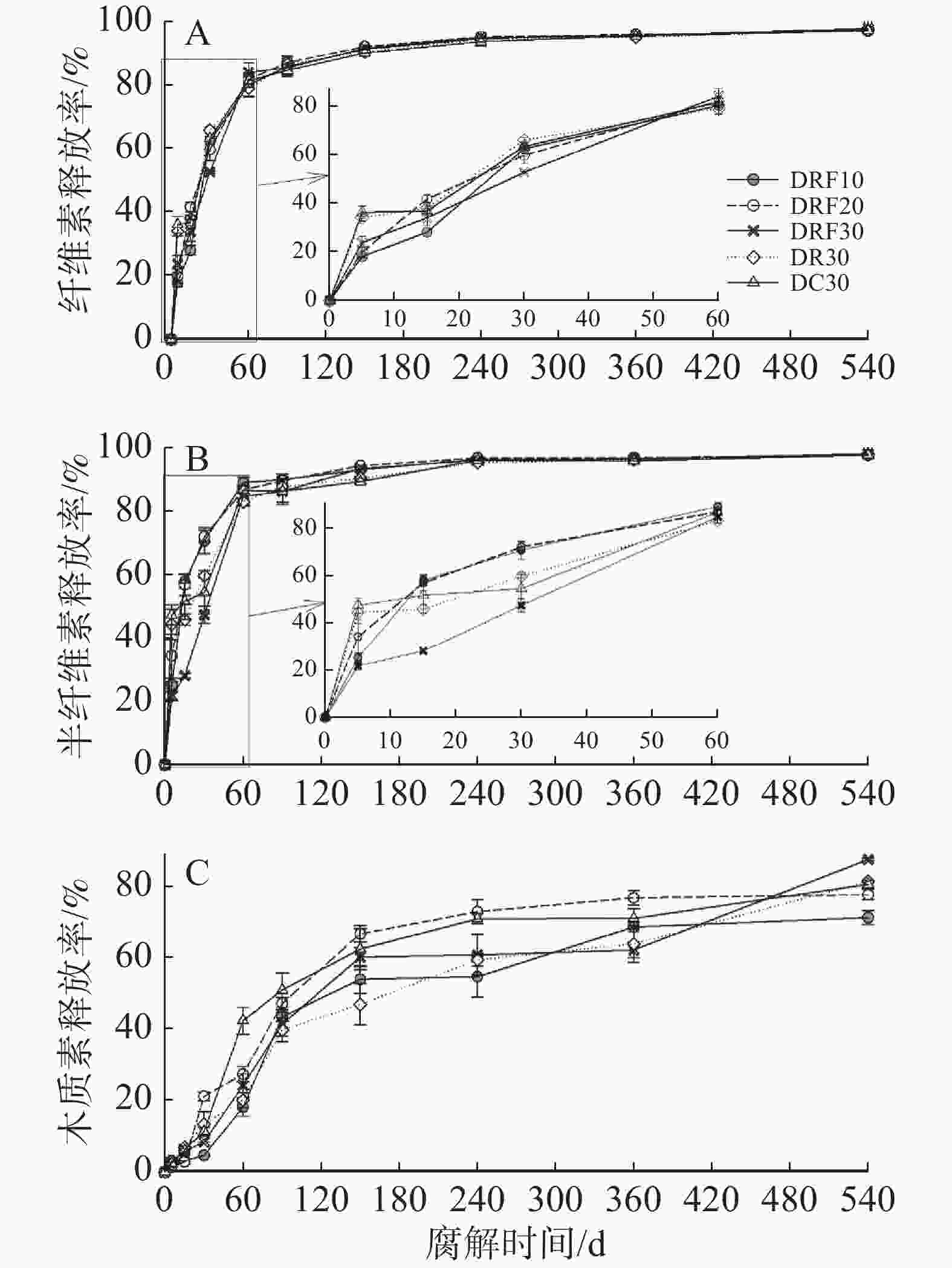
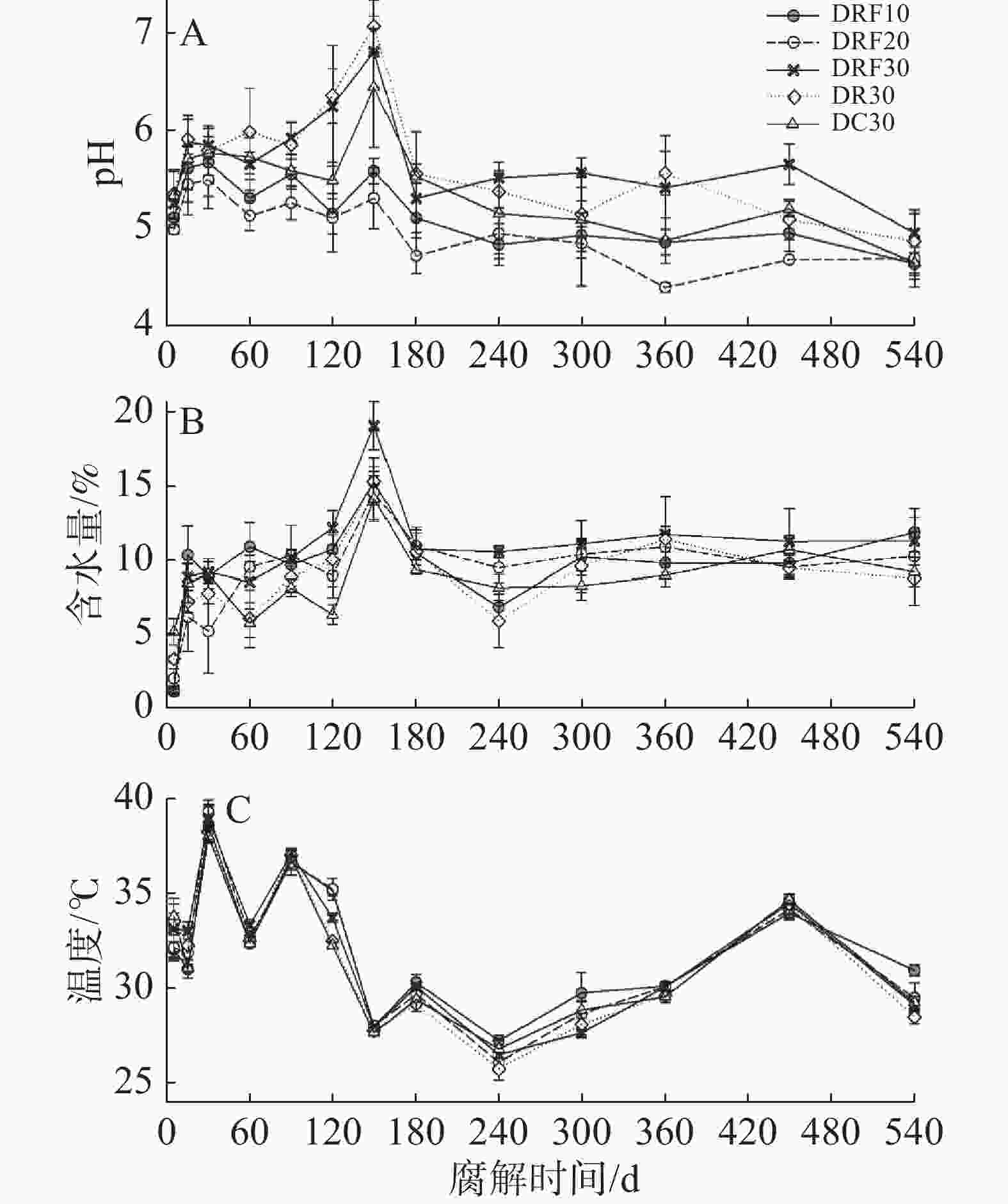
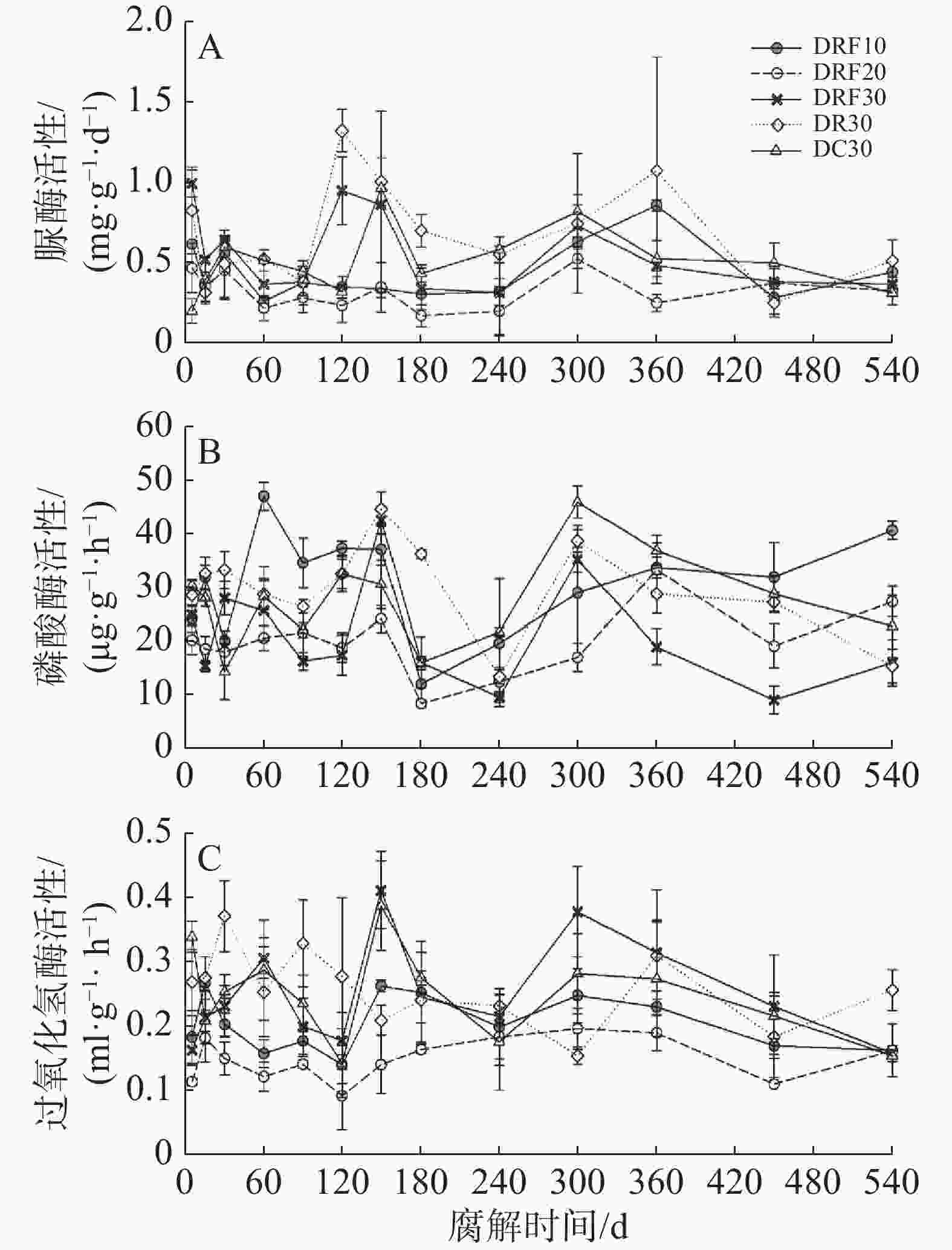
 DownLoad:
DownLoad:
